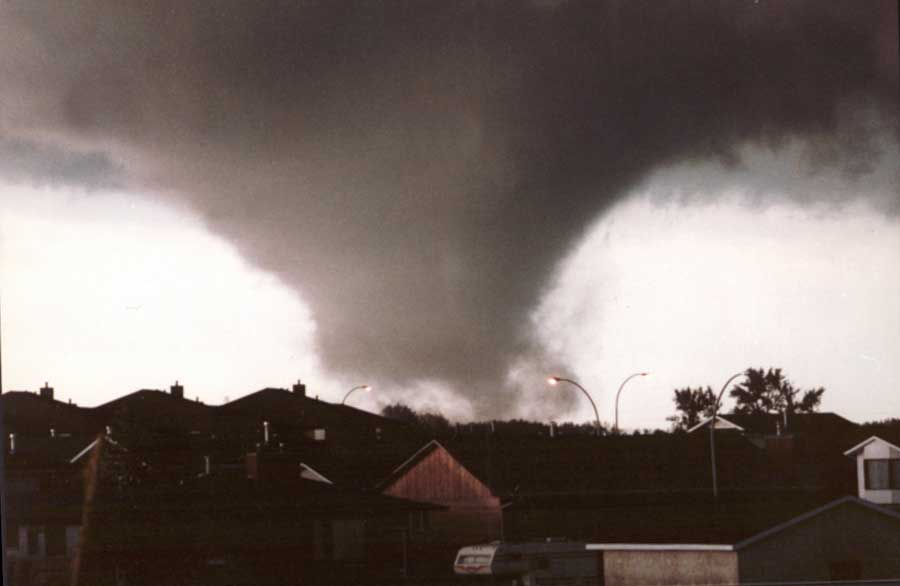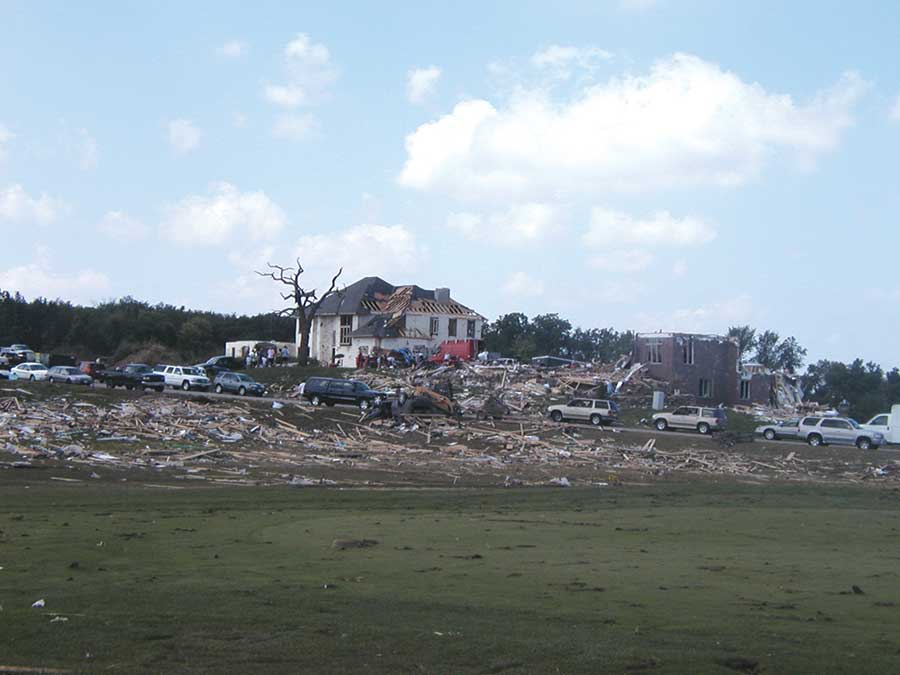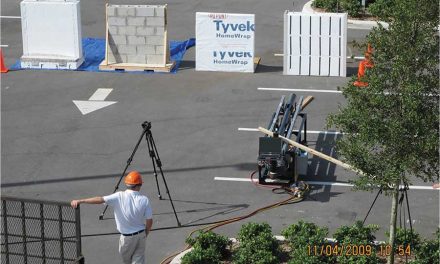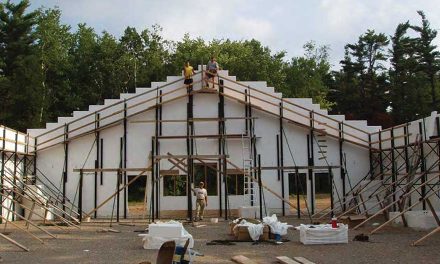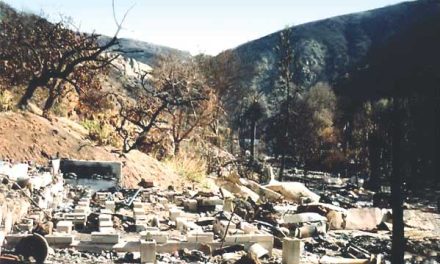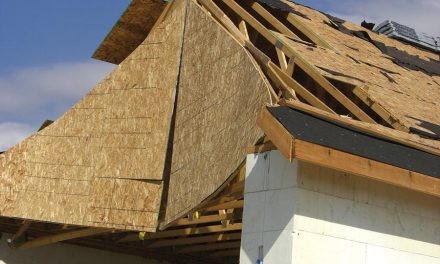Flying Debris Can’t Penetrate ICF Walls
Every year, more than 1,000 tornados touch down in the United States, causing millions of dollars in damage and scattering the victim’s personal treasures over miles of ground. A surprising number of ICF homes have sustained direct hits from tornados, and all of them have stood up to the pounding very well.
When a twister roared through Osage Beach, Missouri, contractor Frank Lee hid his parents, children, grandchildren and friends—about 25 people in all—in a vacant three-bedroom home he was just finishing.
Made of six-inch reinforced concrete walls, it’s built to withstand tornado force winds, and the objects blowing in it. Flying debris is the biggest danger to people and property when hurricanes and tornado’s strike. “Any tornado we’ve had here, this would stand up to it,” Lee said. “ICF construction, while still an exception, is catching on in Missouri,” said Jeff Barber, a registered architect and environmental design specialist based in Lamar, Mo.
“After a tornado hits, we’ll spend days, even weeks, answering the question ‘What can I do to protect my family against a tornado?’ This is one of the things we suggest.”
With Barber’s assistance, Pierce City, Mo., built a new fire station and community storm shelter with ICFs after a tornado demolished the previous building in May 2003.
“The fire station itself can stand up to F-3 tornados and the shelter F-4 tornado conditions, with winds reaching 200- to 250-mile-per-hour for three-second gusts,” Barber said.
In San Antonio, Texas, a Thermoblock home with a wood-frame addition was hit by a tornado. The addition was destroyed, but the ICF portion survived intact.

An F-3 tornado tore the roof off this Kansas ICF home, but the walls stood strong and saved the life of the owner.
Washington, Iowa
The home of Monte Asbury, pastor of New Oaks Church in Washington, Iowa, was less than a year old when disaster struck. On the night of May 15, 1998, he and his wife, along with their 7-year-old son, returned from a short trip to find their neighborhood covered in debris and swarming with police officers.
An F-3 tornado with winds up to 200 mph had touched down there only two hours earlier, and many homes on the street were completely destroyed. The Asburys’ first concern was for their two children—Hannah, age 16 and Ben, age 12—whom they had left at home. They were relieved to find their children safe and their house almost intact. The two teenagers had waited out the storm in a windowless section of the basement, and reportedly experienced nothing more than their ears popping. “They said it felt like their ears were being sucked out of their heads,” says Rev. Asbury.
Although the Asbury house was in the direct path of the tornado, it suffered minimal damage. The 6-in.-thick ICF walls, built with iForm from Reward Wall, had prevented most of the damage to the home.
Most of the damage was caused by a huge tree that snapped in the storm and fell onto the roof. While several roof trusses were damaged and pushed aside, the roof of the house remained intact because the builder had secured it to the walls with hurricane clips. “Our roof framer installed the hurricane clips just because he thought it was the right thing to do,” said Asbury. “We probably would have lost the entire roof without the hurricane straps. The contractor who helped build the house said he was absolutely certain a wood wall would have been crushed by the tree that fell.” The only other visible damage was a garage door that had buckled under the tremendous air pressure.
From where Asbury sits in his office, he can look out the window and see six bare foundations between the church and his house one block away. “Several people have come up to say, ‘I’ll bet you’re glad you built a concrete house.’ If I had more time I would be selling Reward houses here,” he says.
Attica, Kansas
Randy and Linda Robbins, who live on the outskirts of Attica, Kan., had only a few moments to prepare for the tornado that suddenly dropped from the sky in May 2004.
“We’d been looking through our window watching the storm,” says Linda, “when suddenly the front door blew open.” The couple raced toward the basement of their newly constructed home, built with ECO-Block ICFs, and prepared for the worst.
Powerful winds leveled all the surrounding buildings, and tore the roof from the Robbins home. But the walls stood strong. “If it weren’t for the ECO-Block walls, we wouldn’t be here right now,” Linda says. “I saw what a tornado from the same storm did to a wood frame home,” says Robbins. “It ripped the floor out and filled the basement with debris. We’re very lucky we decided to build with [ICFs].”
The dramatic encounter, caught on film by a professional storm chaser, can be viewed on our website, www.icfmag.com.
“Funny, safety was a secondary consideration when we chose to build with ECO-Block,” says Randy Robbins. “For us, the greatest benefit was its energy efficiency. Yet we’re alive today because of these walls.”
Stoughton, Wisconsin
The durability of ICFs was proven yet again when an F-3 tornado tore through Stoughton, Wisconsin on August 18th, 2005. A total of 45 homes were leveled or sustained moderate to severe damage in the immediate area.
Flying debris is the primary cause of injury and death during tornadoes and hurricanes. This storm was so severe debris from the neighborhood was found 75 miles away in Milwaukee.
An ICF home, also built with Reward, was nearing completion when the storm hit. Boyd Coleman, a structural engineer, was called in to assess the damage. “Although I’m familiar with ICF construction, this was the first I had seen of an ICF building that had gone through something like this,” Coleman said. “I was surprised to see so much debris stuck in the foam.” One photo shows a 2×4 stuck in the foam stopped by the reinforced concrete.
“We lost the roof of the garage and screened-in porch, and all the windows were broken,” says homebuilder Randy Settersten of Settersten Builders. Still, he estimates that progress will be back to where it was the day before the storm within two to four weeks from the date of the storm.
“This event confirms everything we have always said about ICF construction,” says Reward President Ed Storm. “It graphically illustrates that ICF walls can save lives. That’s why we work so hard to get the word out about our product’s safety.”
Reward Wall Systems is offering a $1 per-form discount to those who rebuild in the wake of hurricanes or tonados. Visit www.rewardwalls.com for details.

